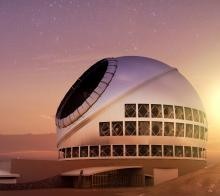TMT Hearing: Last TIO Witnesses Testify
Judge Riki May Amano implemented a new policy at the contested case hearing for the state Board of Land and Natural Resources Conservation District Use Application (CDUA) on the TMT International Observatory’s (TIO) Thirty Meter Telescope (TMT) on Wednesday, Jan. 4, in Hilo.
Stemming from a dispute between Judge Amano and petitioner Harry Fergerstrom, all parties and councils must now sign in and out with a DLNR officer each time they enter or exit the Crown Room at the Grand Naniloa Hotel due to safety concerns. Judge Amano said she feels responsible for everyone there.
Before the change, petitioner Pua Case finished her cross-examination of Dr. Gary Sanders, the TMT project manager.
After a worldwide search for potential observatory locations, Sanders made a recommendation to remove one of its selected Chile sites because of its mountain’s sacredness to the Atacama tribe. It was dropped from the list.
Case asked why Mauna Kea wasn’t dropped off their list due to its sacredness to the Native Hawaiian people. Sanders answered that he couldn’t speculate and replay history.
It was earlier confirmed by Sanders that the telescope structure would be 180 to 187 feet tall and 21-21.5 feet below the ground.
Case asked when the decommissioning phase begins, how he expected the mountain to be restored when they would have excavated that deep into the ground.
Sanders answered by saying that the mountain cannot be perfectly restored to its natural state. He offered reassurance that with approximately 1,000 photos already taken at the observatory site and 600 at the Batch Plant, along with the Decommissioning Plan for the Mauna Kea Observatories, whoever is commissioned with restoring the site would be equipped to do so.
On Thursday, Jan. 5, Dr. Heather Kaluna was called as a witness. Kaluna was born and raised in Pāhoa and is now a post-doctoral fellow at the Hawaii Institute of Geophysics and Planetology.
Petitioners Fergerstrom, Case, Kealoha Pisciotta and Lanny Sinkin declined to cross-examine her. Sinkin said his reason was because using Kaluna as a witness was a means of pitting Hawaiians against Hawaiians.
In her written testimony, Kaluna stated that because she watched Pele—referring to lava as the deity—come down the pali and make her way through the town of Kalapana, she said she has “a great appreciation for Pele and her presence in my home community.”
Petitioner Mehana Kihoi asked if she would support an 18-story structure on Kilauea. Kaluna said if it was for a good reason, like education, then yes.
Non-profit PUEO (Perpetuating Unique Educational Opportunities) Attorney Lincoln Ashida asked why she supported the TMT observatory. Kaluna answered that it would further education for Hawaiʻi children and because they’re doing it with honorable intentions in a culturally sensitive way.
The last witness for the TIO to be called was Dr. Paul Coleman, a specialist astrophysicist at UH Mānoa’s Institute for Astronomy.
In his written testimony, Coleman regarded Mauna Kea as a special place, but through his research, found that “there were no ʻsightline’ ceremonies, no equinox celebrations and with the exception of the treatment of piko in Waiau, no cultural practices at all.”
Coleman, who clarified he wasn’t a Hawaiian cultural practitioner or expert, said there’s no mention of Mauna Kea in the Kumulipo (Hawaiian creation chant), and challenged cultural experts to present Mauna Kea as the piko (umbilical cord) of Hawaiʻi Island, whether in text or oli (chant).
Petitioner Deborah Ward asked Coleman why two-thirds of his testimony speaks about Hawaiian culture as opposed to focusing on his expertise in astrophysics. He answered that there are many astrophysicists present in Hilo, but none who are also Native Hawaiian. By doing so, he said he adds his cultural perspective and that brings cultural balance.
Starting next week, witnesses in opposition of the TMT project will be called to testify and be cross-examined. Some of those names include, Kealoha Pisciotta, Pua Case, Paul Neves, Clarence Kukauakahi Ching, Candace Fujikane and Jon Osorio.
The BLNR contested case hearing is scheduled to continue Jan. 9, 10, 11, 12, 19, 23, 24, 25 and 26 in the Grand Naniloa Hotel Crown Room in Hilo from 9 a.m. to 4:30 p.m.
Sponsored Content
Comments









